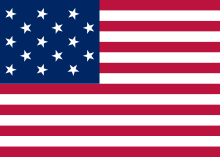Flag Acts (United States)
The Flag Acts are three laws that sought to define the design of the flag of the United States. Each is remarkably short, the shortest being a sentence of 31 words, and the longest being a title and two sentences of 117 words.
Flag Act of 1777
The Flag Act of 1777 ("Journals of the Continental Congress, 1774–1789, 8:464".) was passed by the Second Continental Congress on June 14, 1777, in response to a petition made by an American Indian nation on June 3 for "an American Flag."[1] As a result, June 14 is now celebrated as Flag Day in the United States.
Text
- Resolved, That the flag of the thirteen United States be thirteen stripes, alternate red and white; that the union be thirteen stars, white in a blue field, representing a new constellation.
Flag Act of 1794

The Flag Act of 1794 (1 Stat. 341) was signed into law by President George Washington on January 13, 1794. It changed the design of the flag to accommodate the admission into the Union of the states of Vermont and Kentucky. It provided for fifteen stripes as well as fifteen stars. This would be the only official flag of the United States not to have thirteen stripes.
Text
- An Act making an alteration in the Flag of the United States.
- Be it enacted by the Senate and House of Representatives of the United States of America in Congress Assembled, That from and after the first day of May, Anno Domini, one thousand seven hundred and ninety-five, the flag of the United States, be fifteen stripes alternate red and white. That the Union be fifteen stars, white in a blue field.
Flag Act of 1818
The Flag Act of 1818 (3 Stat. 415) was enacted by Congress on April 4, 1818. It provided for the modern rule of having thirteen stripes to represent the original thirteen colonies and having the number of stars match the number of states. It also provided that subsequent changes in the number of stars be made on July 4, Independence Day.[2]
Text
- An Act to establish the flag of the United States.
- Be it enacted by the Senate and House of Representatives of the United States of America, in Congress Assembled, That from and after the fourth day of July next, the flag of the United States be thirteen horizontal stripes, alternate red and white: that the union be twenty stars, white in a blue field.
- And be it further enacted, That on the admission of every new state into the Union, one star be added to the union of the flag; and that such addition shall take effect of the fourth day of July then next succeeding such admission.
References
- ↑ Mastai, pg 43. "Three strings of wampum" were sent with the petition to cover the cost of the flag.
- ↑ "Fifteenth Congress, Session I, Chapter 34". The Library of Congress. 1818. Retrieved March 12, 2009.
- Mastai, Boleslaw and Marie-Louise D'Otrange 'The Stars and the Stripes. The American Flag as Art and as History from the Birth of the Republic to the Present' ©1973. Alfred A. Knopf, New York. ISBN 0-394-47217-9